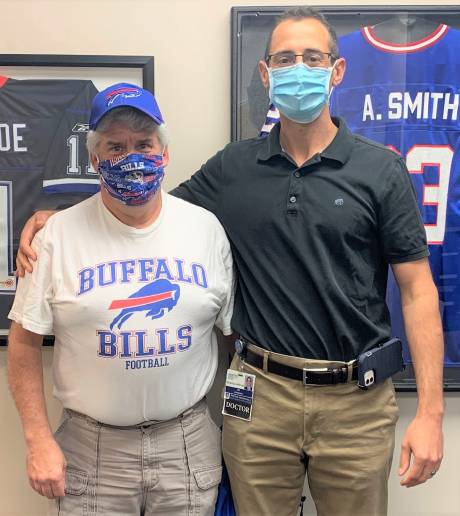
The Buffalo Bills, based on two playoff victories last season and a franchise quarterback in Josh Allen, are on the short list of teams favored to make it to Super Bowl LVI. Expectations are high as the franchise has clawed its way back to being one of the National Football League’s elite teams.
One of their longtime fans, Robert “Bob” Neeley of Warsaw – motivated to a large degree by his passion for the team – is fighting his way back from two total knee replacement surgeries that utilized Robotic Surgical Assistant technology at United Memorial Medical Center.
Neeley, a 30-year employee of the Wyoming County village’s Department of Public Works, already has exceeded the expectations of his surgeon and physical therapists as he has received clearance to attend the Bills’ season opener this Sunday.
The Bills kick off their schedule with a 1 p.m. contest against the Pittsburgh Steelers at Highmark Stadium in Orchard Park.
“That’s been my big goal – to go to the Bills’ game this coming Sunday,” Neeley, a season ticket-holder since 2001, said during a Zoom call this afternoon with his surgeon, Dr. Nicholas Loffredo, chief of Orthopaedics at United Memorial Medical Center in Batavia.
“I’m glad that I got both knees done and that I can actually do it. It’s going to be exciting with all the fans and that I’m going to be there. It’s going to be great because my cousins have been looking forward to me going, too.”
Neeley, a 1982 Warsaw Central graduate, has been a Bills’ fan since the mid-1980’s – “I cheered for them at Ralph Wilson Stadium (as it was called then) and cried during the Super Bowls,” he said.
He said that prior to COVID-19 that he and his three cousins went to all the games since purchasing season tickets 20 years ago. That tradition seemed to be in jeopardy this year due to the condition of Neeley’s knees.
“I had a tremendous amount of pain in both knees … and have been off work since November 2020,” Neeley said. “I got out of the dump truck and it twisted and swelled up. There was no way that I could keep working.”
He said that the pandemic and other factors resulted in surgery being cancelled three times. The plan was to have the left knee done after the first of the year (2020) but when Neeley’s wife, Susan, was stricken with cancer, it was postponed.
Susan, Neeley’s wife of almost 32 years, passed away in April 2020, leaving a heartbroken husband and daughter.
Neeley had the left knee replaced by Dr. Matthew Landfried in early March and had the right knee replaced on Aug. 2 – just five weeks ago – by Dr. Loffredo.
Since then, Neeley has been working extra hard to reach his goals of attending the game and returning to work.
“I feel that my wife is pushing me to do it; to keep going,” he said, fighting back the tears.
“I’ve been doing everything they say and the therapist has been making me work, and I’m doing what I am supposed to at home on my exercises,” he said. “(I) go to therapy twice a week and everything is going really good.”
Dr. Loffredo called Neeley an “ideal patient,” adding, “You give him an objective, and he’s going to get there.”
“You couldn’t ask for a better patient to work on because he’s very motivated … That’s what it is after a knee replacement … it’s doing the exercises and then you get an excellent result.”
The doctor explained that the use of robotics leads to consistent outcomes in terms of balancing the knee.
“The added benefits of the robot is that you get some numbers, whereas before it was more of a feel or an art to what we call soft tissue balancing,” he said. “So, during surgery … (with a) traditional knee replacement, it’s the surgeon feeling how is this knee balanced, side to side. You know it bends, like a hinge, but side to side how is the soft tissue balance?”
Dr. Loffredo said the robot provides data while the surgeon is “gapping” the knee.
“As opposed to with the robot, you literally get feedback while you’re gapping it – you’re two millimeters gapped on the inner, you’re one millimeter gapped on the outer side. So, we’ll make these cuts just so. We’ll release ligaments slightly to gap balance it. It gives you numbers whereas before it was more of a feel or an art. Now, you can quantify it and it makes it more reproducible.
“There’s good evidence that shows patients have a more reproducible result and there’s less revisions and basically better patient satisfaction and hopefully a fast recovery.”
Dr. Loffredo said he’s glad that UMMC is able to offer “that cutting edge service.”
“I believe that the robot is an additional tool to use in the OR (operating room) that in my hands helps to create a reproducible joint replacement, where we’re having a straight knee and a balanced knee each and every time,” he said.
Neeley said he couldn’t be happier in how things are turning out for him, and hopes the Bills can equal or better their performance of last season.
“I don’t know if they will beat out what they did last year; they did so well,” he said. “It’s going to be real tough … but they’ve got a good defense.”
And, the offense is led by a Pro Bowl signal caller.

Photo at top: Warsaw resident Bob Neeley giving his all in physical therapy to bounce back from two knee replacement surgeries. Photo at bottom: Neeley and Dr. Nicholas Loffredo. Photos submitted by United Memorial Medical Center.
